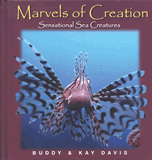There are six species of nautilus found in the southwest Pacific. The anatomy of the nautilus is very complicated. It was not studied in any detail until 1831 when Sir Richard Owen received a live specimen, beginning a brilliant career for him. He was known as the greatest anatomist of his time. It was over 100 years before anyone else studied the magnificent nautilus.
The nautilus swims at night, propelling itself by a form of jet propulsion. It uses its funnel to pump water in and then the muscles contract, forcing the water out. Nautiluses have four gills located inside the funnel, so breathing takes place as the water goes in and out.
During the day, the nautilus remains close to the bottom either by attaching its tentacles to a solid object or by just suspending itself. It is mostly withdrawn into its shell with the eye exposed just enough to see. It will withdraw completely if alarmed.
The nautilus has many tentacles. There is one in front and behind each eye with the outer circle of 19 pairs. An inner circle of numerous tentacles surrounds the mouth and powerful beak. The first and third of these tentacle rings can be withdrawn into sheaths. The tentacles do not have suckers but are ridged in order to have a very strong grip.
When searching for food, the tentacles are extended. As soon as food is grasped, the tentacles pass it to the tentacles around the mouth where the beak breaks up the food.
There is not much known about the breeding or gestation of the nautilus. It is thought that the first four chambers of the shell are formed while the young nautilus is still within the egg. After that, the body of the nautilus lays down a new chamber every two to three weeks.
It is amazing how each chamber, which is initially filled with water, is emptied of the water to be replaced by gases. These gases make the shell buoyant in the water.
Nautilus
Tetrabranchia • Nautilidae
Nautilus pompilius
Length: Shell can be up to one foot (30
cm) across.
Life Span: Unknown
Special Design Feature: The nautiluses have
numerous tentacles that grasp their food
with a strong grip.
Did You Know? The nautilus lives in a
beautiful spiral shell with about 30
different chambers inside the shell.

Marvels of Creation: Sensational Sea Creatures
Brings the world of the sea alive in a unique and colorful way with photographs, a page of facts and commentaries.
Browse Kids BookRecommended Resources
- © 2025 Answers in Genesis
- Privacy Policy
- Contact
- About


